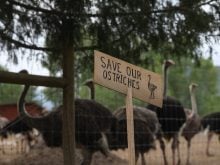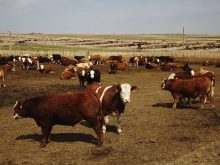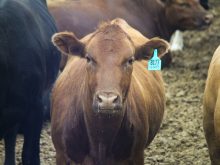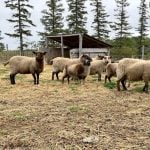LANIGAN, Sask. – Cattle producers thinking about supplementing their animals’ diets with dried distillers grain with solubles (DDGS) got some reassuring news at the Termeunde Research Ranch annual field day last week.
The first year of a feeding trial provided positive results, researcher Amanda van de Kerckhove told a group of some 30 producers standing in a cold drizzle on one of the farm’s fields.
“Feeding DDGS has no negative impact on animal performance at the levels at which we were feeding,” she said.
She added that means a producer’s decision on whether to supplement with DDGS should be based on costs, not any concern over performance.
Read Also

Lending policy still focused on primary producers: Farm Credit Canada
Farm Credit Canada said it has not changed its business practices and remains committed to supporting all producers, after a report from an Ottawa-based media outlet claimed otherwise.
The study was prompted by concerns over a trend toward increased use of low quality forages in beef cow diets as producers try to reduce costs.
Feeding low quality forage requires the addition of nutritional supplements, especially in the second and third trimester of gestation, she said.
Protein supplements are ideal because the nitrogen in crude protein is beneficial for rumen health and function.
The development of the ethanol industry has increased the availability of distillers grains, which are “nutritionally dense” byproducts high in crude protein, said van de Kerckhove.
The ethanol fermentation process removes starch from the feedstock, which increases the concentration of all other nutrients by three times.
DDGS contains up to 39 percent protein, high digestible fibre and fat, and low starch. Concerns about DDGS include high levels of nitrogen and phosphorus in manure if fed in excess, and high sulfur.
Two experiments involving 48 Angus cows were done at the facility last year, designed to evaluate animal performance under two separate feeding regimes that included DDGS. An economic analysis was also done for each trial.
- The first experiment, looking at extended fall grazing systems, compared a DDGS supplement, a commercial canola meal supplement and a control diet with no supplement.
The cows were managed on stockpiled crested wheatgrass pasture from Oct. 3 to Nov. 6, 2007. No significant difference was found in cow body weight, body condition score or rib and rump fat measurements.
Total production costs were $1.10 per head per day for DDGS, $1.36 for the commercial canola meal and 75 cents for the control group.
The cost of gain was $1.88 per kilogram for DDGS, $2.92 for canola meal and $2.87 for the control.
- The second experiment looked at supplementation in straw-chaff wintering systems, comparing a DDGS supplement, a 50-50 mix of DDGS and barley supplement, with a rolled barley supplement serving as the control group.
The cows were managed on barley straw-chaff piles from Nov. 17, 2007, to Jan. 2, 2008.
The body weight change for cows supplemented with rolled barley was significantly less than for the groups receiving DDGS or the 50-50 supplements. There was no significant difference in body condition score or rib fat, but rump fat was different between the DDGS and the barley groups.
Bart Lardner, senior research scientist at the Western Beef Development Centre that operates the Termeunde ranch, told producers DDGS is a “great” supplement.
“It beats the crap out of barley and any other supplement,” he said. “But the bottom line is what it costs you to use it on your farm.”
When the study was done, DDGS cost $140 a tonne, barley $180 and the commercial canola meal $350. Today those costs are around $185 for DDGS (less for DDG) and around $220 for barley.
Van de Kerckhove said the companies that produce DDGS are starting to view it as a valuable product.
“Initially we thought there would be so much ethanol and so much DDGS available that the price would stay down,” she said, but that hasn’t turned out to be the case.
“Maybe it’s not economic now but if ethanol production ramps up, that could change.”














